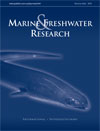Marine and Freshwater Research
Volume 64
Number 4 2013
This study provides updated life history information for two commercially important sharks from northern Australia; the spot-tail shark, Carcharhinus sorrah, and the Australian blacktip shark, Carcharhinus tilstoni. Quantitative relationships among age, growth and reproductive biology are presented for both species. The findings indicated that C. tilstoni, in particular, begins reproducing at an older age and lives longer than previously thought.
The stable isotope analysis of fatty acids is an important tool for identifying the source of these compounds in environmental waters. This work tests the methodology for extraction of fatty acids from water samples and provides recommendations for the use of solid-phase extraction techniques. These protocols enable accurate measurements to be made on samples extracted in the field enabling application to many environmental contamination studies.
Phytoplankton growth and distribution in eutrophic lakes might show a high degree of change within and between days. To monitor those changes, an experiment for the continuous (i.e. every of 5 min.) monitoring of chlorophyll-a concentration (Chl-a), by using a radiometric system that measures water reflectance, has been developed. A relation for retrieving Chl-a from a combination of reflectances at near-infrared wavelengths has been built The results show that Chl-a concentration can vary from 20 to 130 mg m–3 during a single day. The analysis of Chl-a measurements and meteo-climatic parameters for ~30 days, showed that solar radiance and wind speed are key factors regulating phytoplankton growth in Mantua Superior Lake (northern Italy).
Three widely used mark–recapture methods were evaluated to estimate the population size of a trichodactylid crab from an alluvial plain. A preliminary trial, previous to the field application, assessed the most accurate estimator and helped to improve the estimation of the field study and satisfaction of the assumptions. The environment and species features must be considered previous to the final application of these methods.
Electronic tags can be used to obtain information on fish migrations, but optimal tagging methods are required to ensure that tagged fish survive and exhibit a natural behaviour. Effects of implanting data-storage tags in European eel were examined. Surgical implantation into the body cavity appears to be a suitable tagging method for eel, and it is recommended to close incisions using permanent monofilament sutures. Eels have particular morphological, physiological and behavioural features that require explicit evaluation and adjustment of tagging methods.
Individual size is a key variable in biology and ecology but many small organisms that lack hard parts are difficult to measure accurately. We present the first consistent, non-lethal method for measuring Hydra, a common freshwater polyp and scientific model organism. This method makes it easy to answer questions about the individual size and growth of Hydra and other small flexible animals.
Estuarine communities are highly sensitive to climate-mediated temperature variation and sea-level rise. We examined osmoregulation and survival of estuarine mysids to determine the potential impacts that changing temperature and salinity might have on estuarine epibenthic communities. The research identified non-linear impacts of temperature and salinity on mysid mortality that suggest community responses to these variables are likely to be unpredictable.
This study investigates the spatio-temporal distributional patterns of siphonophores in the waters around Taiwan. Monsoon-driven dynamics of currents are proven to determine seasonal variations in the distribution and abundance of siphonophore assemblages. The study not only broadens our knowledge on the ecological role played by siphonophores but also provides sound evidence of biotic responses to the hydrological situation.
Marine protected areas (MPAs) may help preserve populations of fishery species, but they work only if animals find suitable protective habitat and do not extensively move beyond MPA borders. We quantified California spiny lobster home range, habitat use and survival in a southern California MPA and found that lobsters generally remained within the MPA, associated with rocky habitat that was extensive within the MPA, and exhibited high survivorship. These results match those for many other spiny lobster species, a group of animals that likely benefit widely from MPAs worldwide.




